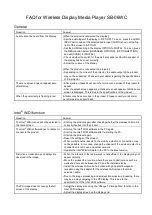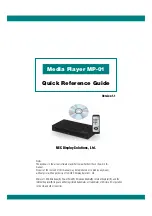
139
9.14 Laser Low Power (LLP).
The LLP output can be used by write-able systems to switch
the laser back to read power when the light spot goes off-
track while writing discs. To prevent that the neighbour tracks
are damaged when the spot goes off-track the laser has to be
switched very fast to the safe read power. The laser is not
switched off (like LDON does), so the system can carry on
reading.
The tracking (radial) and focus error signals are used to
disable the laser write power. This is done through the LLPn,
active low Laser Low Power, signal. Note that LLPn is a servo
output, which is inverted before it is output via the LLP pin, so
the LLP pin is active high.
So, if any of the following conditions is true, the laser write
power is disabled by the MACE2 servo.
–
Off Track, more than a quarter off a track away from the
correct one
–
ORD, radial error signal too large. Larger than the given
setpoint, which should be chosen at a critical write failure
level. An adjustable band pass filter first processes the
radial error signal.
–
OFD, focus error signal too large. Larger than the given
setpoint, which should also be chosen with care. An
adjustable band pass filter also first processes the focus
error signal. All settings of the focus and radial part are
independent.
–
OTR, prot stat flag which becomes active if ORD
becomes active during an actual laser write ( LWR)
action. This flag is reset only by a status read ( RSTAT)
command. So until then LLPN stays active.
–
OFO, prot stat flag that becomes active if OFD becomes
active during an actual laser write action. Same idea as
OTR.
This error detection circuit can be switched off (apart from the
Off Track detection) by raising the setpoint levels to its
maximum value.
9.15 The OPC.
The OPC block in Mace2 is used for the following functions:
During write actions, it stores Pw samples, which can be
evaluated by the microprocessor.
During OPC read actions, it stores A1, A2 and CALF
samples, which are used for calculating the asymmetry
and the modulation index.
The OPC block is used for EFM detection.
During reading of a disc, it stores A1 and CALF samples,
which can be monitored.
Although the OPC block is used for multiple functions, it got
it's name from the OPC procedure, which is it's main task.
The OPC (Optimum Power Calibration) procedure is used in
CD-R/CD-RW/DVD-RAM applications. It is used to
"calibrate" the laser write power in writable systems.
It reads in 3 analogue signals from an analogue pre-
processor like AEGER-2 (A1, A2, and CALF) and the actual
write power (Pw) from the laser controller and feeds an
analogue output signal Alpha0 back to AEGER-2. A1, A2 and
CALF represent the max, min and average value of the EFM
signal respectively. Alpha0 controls the laser write power. All
analogue signals are converted to an 8 bit digital signal.
Conversion frequency at 16.9MHz base clock is 88kHz (each
channel).
Figure 9-4 Definition of the A1, A2 and CALF signals.
9.16 Definition of terms.
The asymmetry ( and modulation index m of the EFM signal
are calculated from the analogue inputs:
9.17 Rough description of the OPC procedure
Basically the OPC procedure tries to find out the optimum
laser power to be used on a specific disc. The OPC
procedure uses about 15 ATIP frames. These frames are
located in the "PCA" area. This is a special part of the disc
used only for power calibration. The drive first checks
whether there are 15 frames "empty" in the PCA. Next the
OPC is performed in these 15 frames.
The OPC operation consists of two stages: A "write" and a
"read" stage. First 15 ATIP frames are written (during which
the OPC block stores Pw samples), and then the same 15
ATIP frames are read back again, (during which the OPC
block stores A1, A2 and CALF samples). During the write
stage, random EFMis written in a test area located on the
inner side of the disc. During this recording the write power is
increased stepwise from a low to a high power level.
Figure 9-5 Figure 5: OPC write profile.
First during 3 ATIP frames the power is increased in rather
big steps (rough OPC). During this action Pw samples are
stored into memory. During the rough OPC, the OPC makes
7 steps per ATIP frame. This gives 21 samples into the OPC
memory. From these samples, the microprocessor can
calculate what's roughly the best alpha0 setting for this
typical disc.
After 2 frames of calculations, another 10 ATIP frames are
written using smaller steps (fine OPC) around the alpha0
setting, which gave the best result during the rough OPC.
The second stage of the OPC procedure is the "read" phase
A1- A2
A1+A2
m
A1+ A2
A1+CALF
Содержание SA-12S1
Страница 46: ...44 Personal notes...
Страница 58: ...Layout AV Board N Europe to p view CL 06532152_064 eps 121200 67 68...
Страница 59: ...Layout AV Board N Europe bottom view CL 06532152_065 eps 121200 69 70...
Страница 62: ...Layout AV Board F S U top view CL 06532152_105 eps 151200 75 76...
Страница 63: ...Layout AV Board F S U bottom view CL 06532152_104 eps 181200 77 78...
Страница 80: ...Layout Mono board Part 1 top side CL 06532152_85a eps 121200 111 112...
Страница 81: ...Layout Mono board Part 2 top side Cl 06532152_85b eps 121200 113 114...
Страница 82: ...Layout Mono board Part 3 top side CL 06532152_85c eps 121200 115 116...
Страница 84: ...Layout Mono board Part 1 bottom side CL 06532152_86a eps 121200 119 120...
Страница 85: ...Layout Mono board Part 2 bottom side CL 06532152_86b eps 121200 121 122...
Страница 86: ...Layout Mono board Part 3 bottom side CL 06532152_86c eps 121200 123 124...
















































